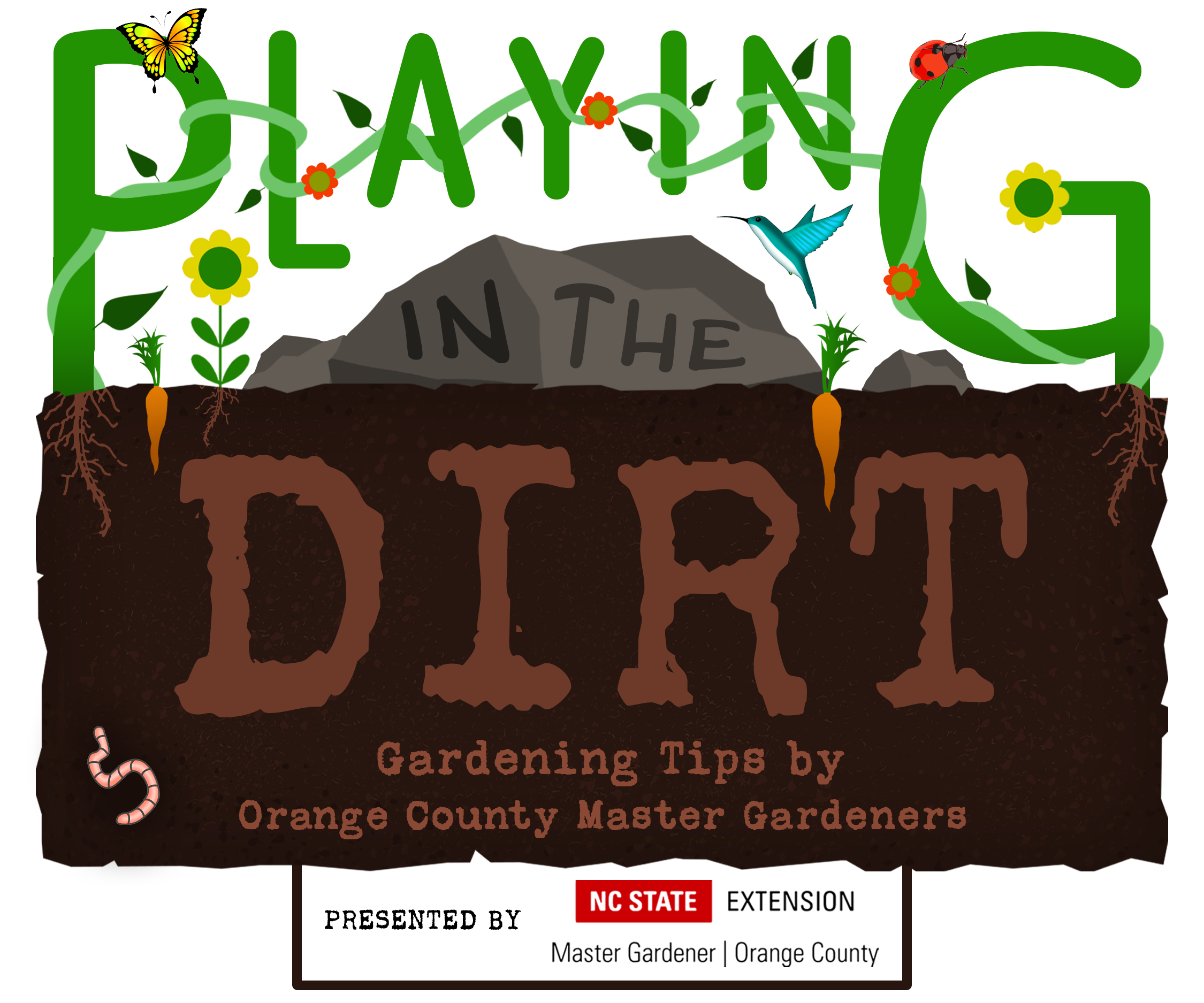
97.9 The Hill and Chapelboro.com have partnered with NC State Extension Master Gardener℠ volunteers of Orange County for “Playing in the Dirt,” a monthly column providing information and inspiration to gardeners of all skill levels! Check back on Chapelboro each month for a new subject – from our gardens to yours!
By Margaret Cloud and Lynn Calder, Orange County Master Gardener℠ volunteers
Don’t Miss These Events!
PlantFest: The Orange County Master Gardener volunteers’ annual plant sale and garden festival is only a few days away on Saturday, October 5th! We hope you’ll join us from 9:00 a.m.–2:00 p.m. at 1020 US Hwy 70 West, Hillsborough (across from the DMV office). There will be something for everyone! Along with all types of plants for sale, including trees, shrubs and flowers (many are natives), there will be kids’ activities, gardening exhibits and demonstrations, a nature art sale, and food to purchase. For more details, visit the PlantFest website.
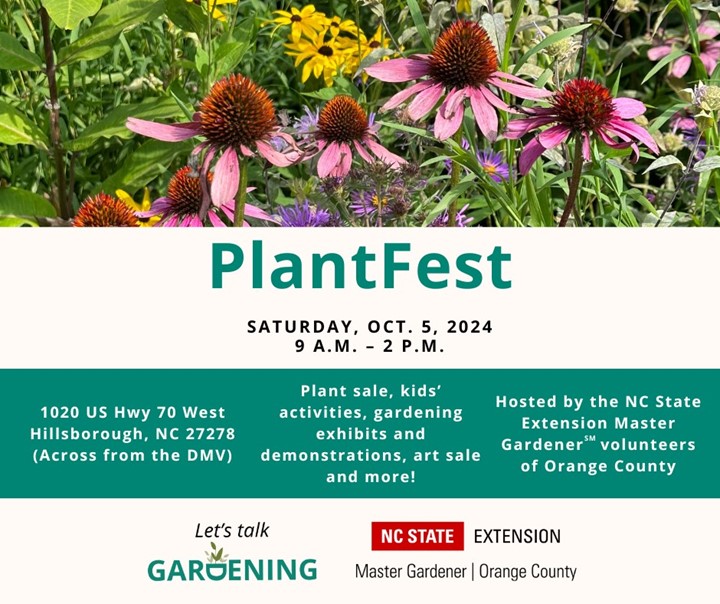
NatureFest: If you enjoyed PlantFest, NatureFest is another family opportunity in October, hosted by the North Carolina Botanical Garden. This free, family-friendly festival on October 19, 1:00–4:00 p.m., will celebrate native plants and animals through a variety of engaging outdoor activities.
Dig Deeper: The Orange County Master Gardener volunteers are excited to partner with the Seymore Center in Chapel Hill for our fall Dig Deeper series on gardening topics. Please join us at 2551 Homestead Rd, Chapel Hill (map) for the following presentations:
- Why Do I Need Native Plants in My Landscape? Lunch & Learn (bring your own lunch), Thursday, October 10, 11:30 a.m.–1:00 p.m.
- Winter Sowing, Thursday, December 19, 10:00–11:30 a.m.
For spring, 2025, Dig Deeper will be back at the Hillsborough Library as well as the Seymore Center. Stay tuned for dates and topics!
Tips for Fall Gardening
Leave Old Perennial Plant Stems: You may have heard that you can help pollinators and other wildlife by leaving perennial plant stems in place over the winter. Some types of bees and beneficial wasps lay eggs and build nests in hollow stems of perennials.
But information about when gardeners should cut back old stems and how far, has been unclear. Two scientists from NC State University, Elsa Youngsteadt and Hannah Levenson, designed a project to find out more about stem cutting and they enlisted Master Gardener volunteers and Extension agents in nine counties to help them.
In the fall, volunteers trimmed perennial stems in their gardens to stand 18 inches above ground level. The following year (in late winter, spring, summer, and early fall), they collected more than 2,000 of the previous year’s stems and sent them to the NC State scientists for examination. Most of the samples collected in spring and summer contained pollinators or beneficial insects, including small carpenter bees, leafcutter bees, potter and mason wasps, and grass-carrying wasps.
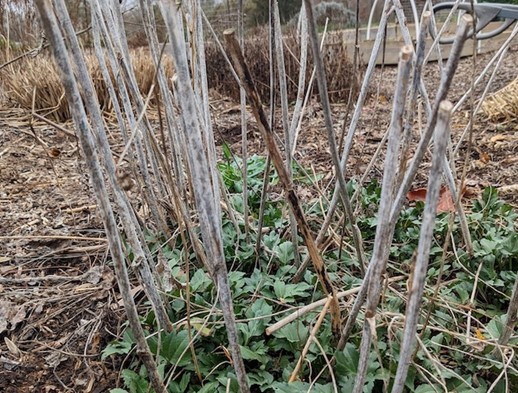
Rudbeckia stems left in place. (Photo courtesy of NC State Extension.)
As a result of the findings, Youngsteadt and Levenson suggest that home gardeners trim perennial stems in fall or winter to a height of one to two feet and leave the stems in place. The stems will provide nesting sites the following spring and summer. The stems will eventually disintegrate and need no further maintenance. If you wait until late winter to trim the stems and seed heads (instead of in the fall), birds and wildlife will be able to feed on seeds. However, if disease exists in the perennial garden, a thorough fall clean-up is warranted.
Read more about this study here: NC State Extension Master Gardener Volunteers Assist Pollinator Research.
Planting Shrubs or Trees: Did you pick up a new shrub or tree at PlantFest or a local nursery to plant this fall? Fall is a good time for planting. With plenty of moisture and cooler temperatures, roots have a chance to grow and become established over the winter.
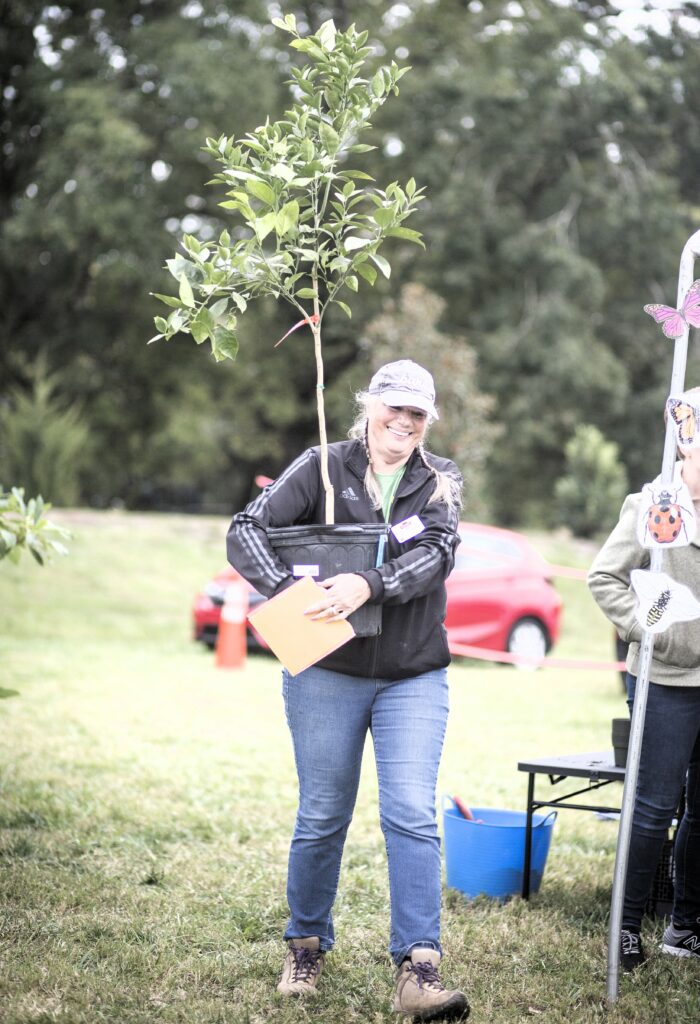
(Photo by Katie Rentzke.)
When deciding where to place your new plant, consider the plant’s light, moisture, and soil needs as well as its full-grown size. If you haven’t submitted soil samples for a soil test recently, the tests are free until the end of November; a small fee is charged from December 1 to March 31. Pick up and drop off soil boxes at the Orange County Extension office, 1020 US Hwy 70 West, Hillsborough.
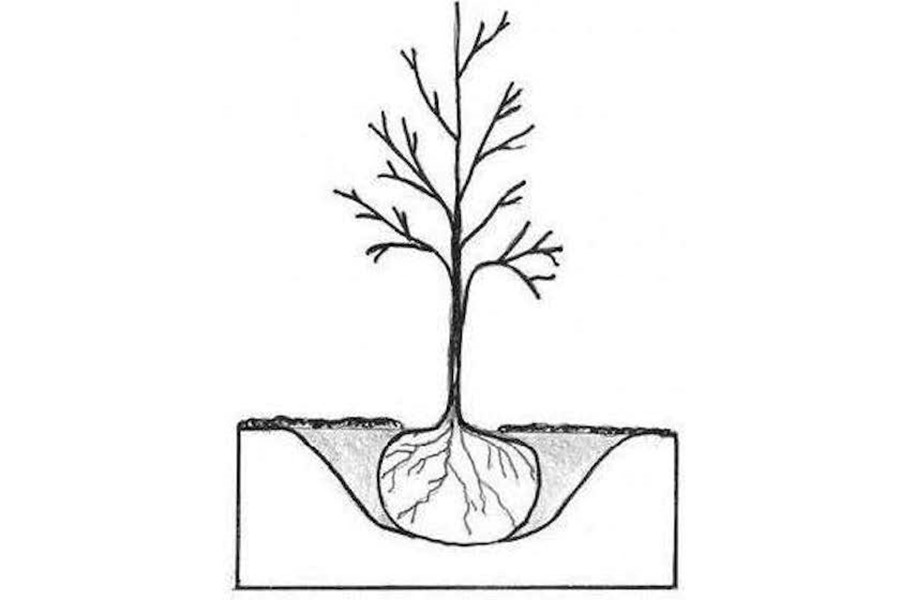
A planting hole for a tree should be twice the diameter of the root ball and no deeper than the root ball. (Diagram courtesy of chatham.ces.ncsu.edu.)
If you need to amend the soil where you’ve decided to plant, prepare an entire planting bed instead of a single hole. Mix one to three inches of organic matter into the top six to eight inches of soil before you dig the new hole; do not add amendments to the planting hole itself. The hole for a tree or shrub should be about twice the width of the plant’s root ball, with gently sloping sides, and no deeper than the root ball. Fill in the hole around the roots with the soil you removed. The crown of the plant should sit just above the ground after the hole is filled. Add mulch on top of the soil but keep the mulch six or more inches away from the trunk; mulch should never be piled against the trunk. Learn more details about correctly planting trees and shrubs here.
Planting and Dividing Perennials: Perennials benefit from being planted in fall for the same reasons as shrubs and trees: less stress due to warm soil, cooler air temperatures, and more consistent moisture.
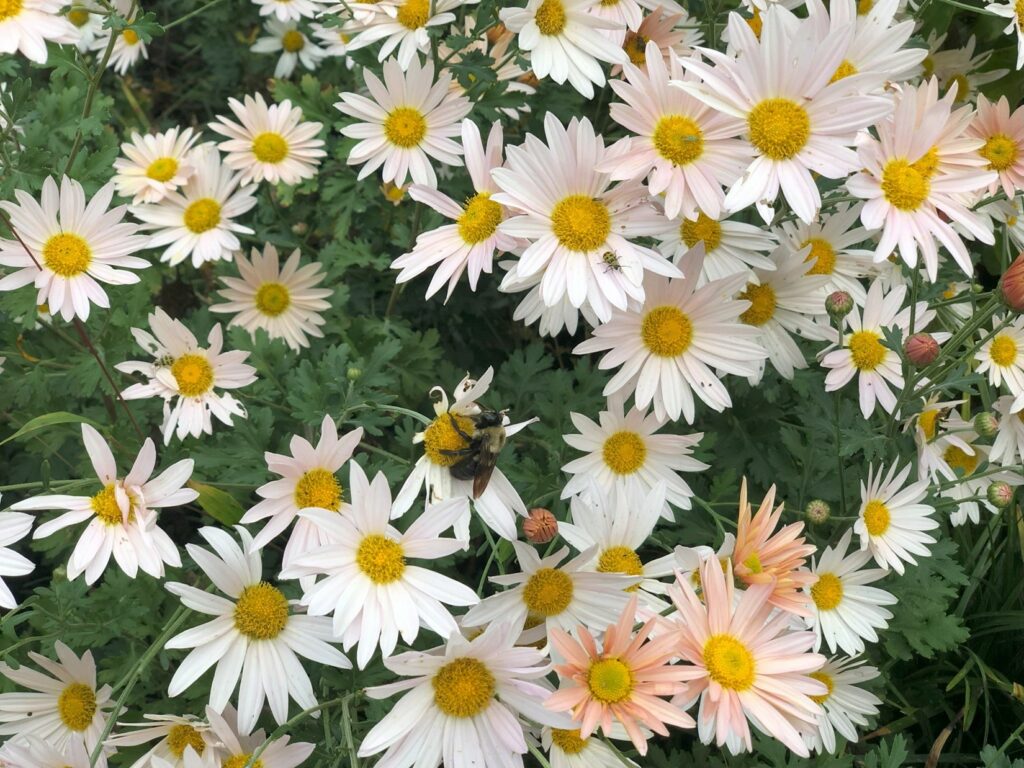
Fall-blooming chrysanthemums. (Photo by Lynn Calder.)
Before planting, prepare the whole garden bed by adding compost or other organic matter as needed. The hole should be at least twice as wide as the plant’s container and the depth equal to the depth of the soil in the container. Being careful not to plant it too deeply, set the perennial in the ground so that the top of the root ball is flush with the overall soil level and backfill the hole with the soil that came out of the hole. A layer of mulch will help retain moisture, regulate soil temperature, and inhibit weed growth. If fall rain is not adequate, new plants should be watered regularly and deeply to ensure they do not dry out. See this University of Maryland Extension article for more information about planting and caring for perennials.
Overcrowded or overgrown perennials benefit from being divided — enjoy sharing your divisions with friends or placing them in another area of your landscape. Divide plants when they’re not blooming. Generally, divide plants that bloom in the spring during the fall and divide those that bloom in the fall during the spring. Read more about how and when to divide your perennials correctly in How Do I Divide Perennial Plants in My Garden?
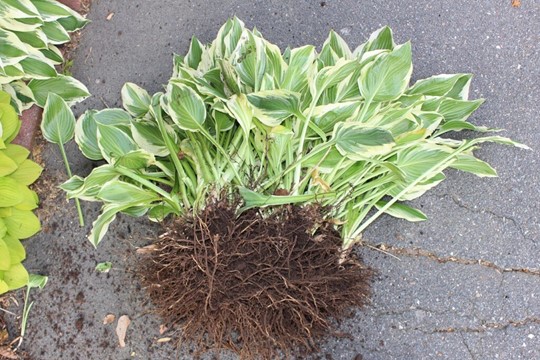
This hosta has been dug up and is ready to be divided. (Photo courtesy of Forsyth County Extension.)
Planting Bulbs: Buy spring-flowering bulbs now when the selection is best, then store them someplace cool and dry for a month or so. Wait to plant the bulbs when nighttime temperatures stay below 60 degrees (usually mid-November to early December in our area). They’re planted in late fall because most need a 12- to 16-week chilling period to produce flowers. For more information about planting bulbs, see this Playing in the Dirt column or attend the free online Chatham County Extension webinar, Spring-Flowering Bulbs, on October 15, 6:30–8:00 p.m., to learn all about selecting, planting, and growing spring-flowering bulbs.
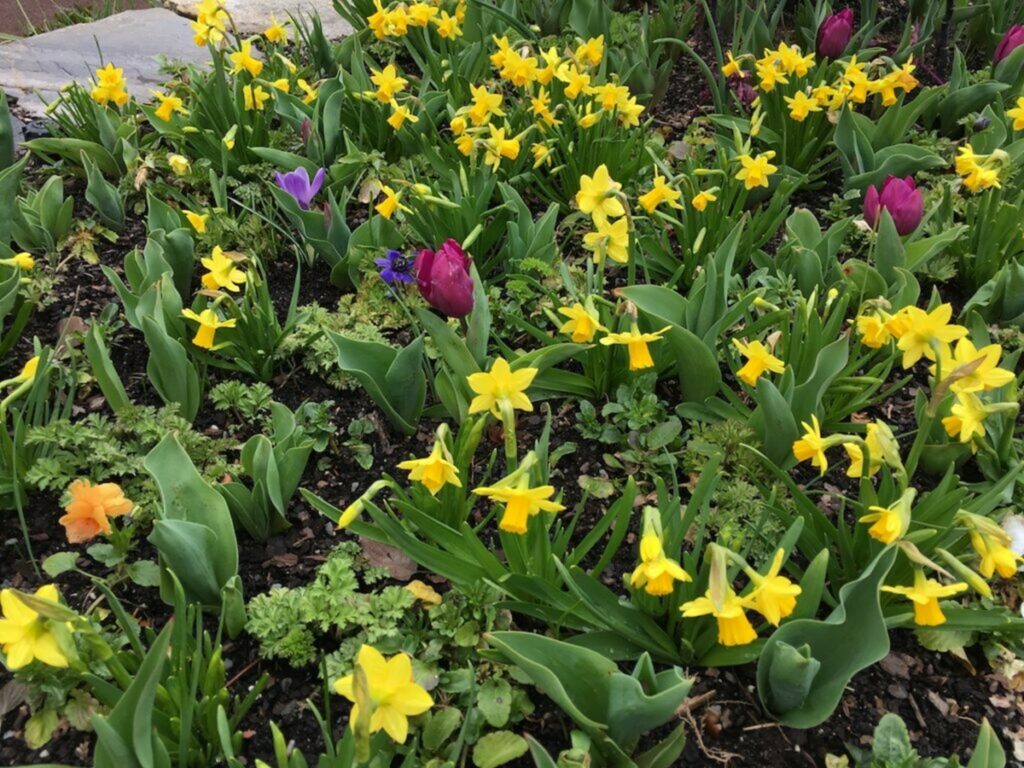
Spring-flowering daffodils, tulips, and crocuses at Duke Gardens. (Photo by Margaret Alford Cloud.)
More from the Master Gardener volunteers of Orange County:
- Have a plant or garden question? Email the Orange County Master Gardener volunteers at ocmgardeners@gmail.com or phone 919-245-2061.
- Subscribe to The Garden Buzz, the Orange County Master Gardeners’ monthlynewsletter, for gardening news and tips. And visit our website, The Orange Gardener, for helpful gardening information and tips.
- Follow us on Facebook! Our page is NC State Extension Master Gardener Volunteers, Orange County.
Chapelboro.com does not charge subscription fees, and you can directly support our efforts in local journalism here. Want more of what you see on Chapelboro? Let us bring free local news and community information to you by signing up for our newsletter.

